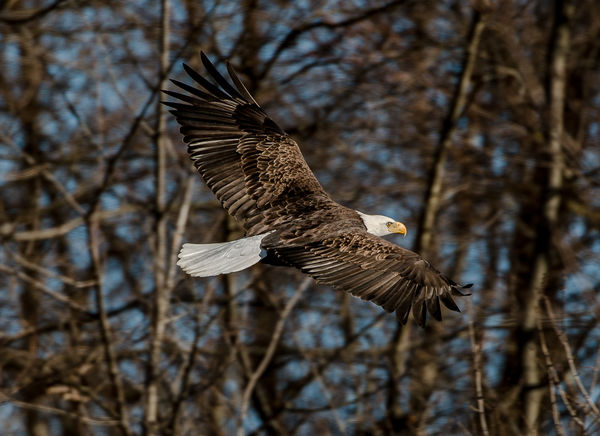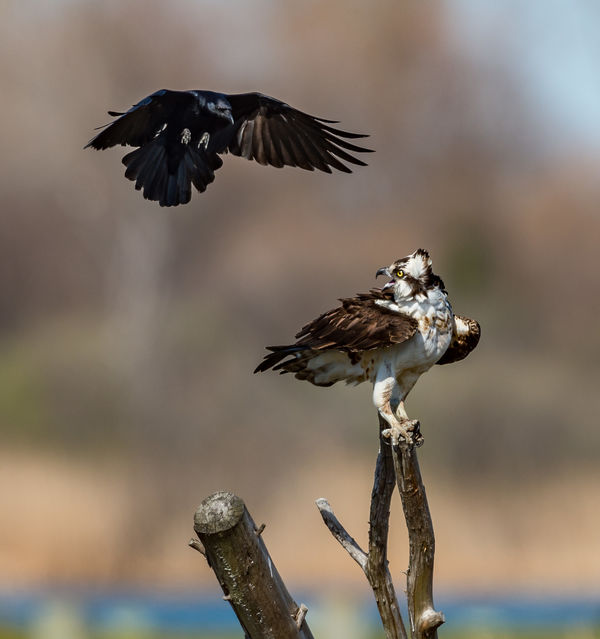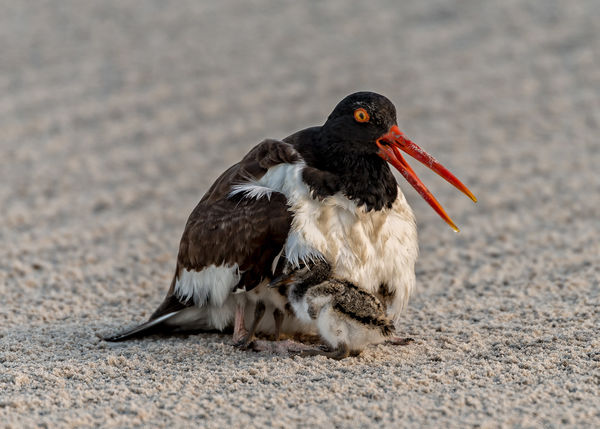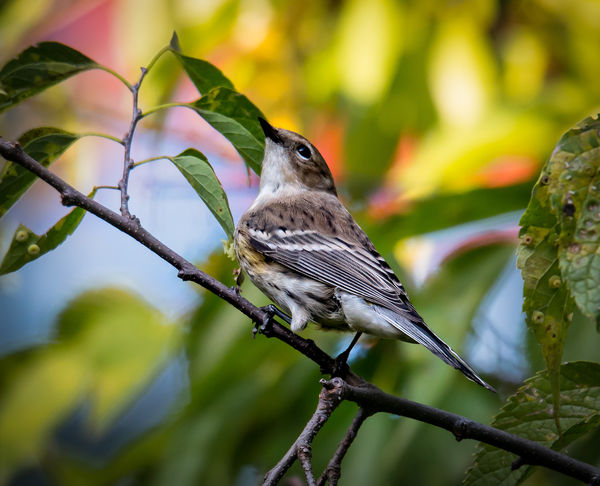Wildlife shooting
Dec 2, 2017 14:54:53 #
Dec 2, 2017 15:10:08 #
If you're photographing bird in flight you'll want a fast shutter speed. For large birds like herons and egrets you can go as slow as 1/1000 second. I try for 1/1250 second or faster. For smaller, faster birds you'll want an even faster shutter speed. If shooting with Nikon use AF-C mode and 3D tracking or Dynamic-area AF. I'm not that familiar with Canon. I think AI Servo is the same as AF-C on Nikon.
Dec 2, 2017 15:20:18 #
CO wrote:
If you're photographing bird in flight you'll want a fast shutter speed. For large birds like herons and egrets you can go as slow as 1/1000 second. I try for 1/1250 second or faster. For smaller, faster birds you'll want an even faster shutter speed. If shooting with Nikon use AF-C mode and 3D tracking or Dynamic-area AF. I'm not that familiar with Canon. I think AI Servo is the same as AF-C on Nikon.
 I start with ISO 3200, 1/500th sec in Aperture Priority and see how it develops.
I start with ISO 3200, 1/500th sec in Aperture Priority and see how it develops.Dec 2, 2017 16:26:53 #
jerrycrowson wrote:
Is there suggested settings to put your camera on for wildlife photography?
It depends, as always, on your subject and your goal. Wildlife sitting down and kickin' back, as some one else has said, shutter speed at, at least, 500, but I'd use 1000 if it will work out. Aperture priority at f/8 might work well. For moving birds, all bets are off, as the saying goes. How fast are the birds moving? Do you want to stop their wings in mid-flight or leave a little blur in the tips perhaps? How dark is it? What color are the birds? So many variables to put together to make it all work. Focusing on moving birds can be difficult and photographing white birds makes it more difficult. You might try a shutter speed of 1000 (I'd actually go up faster if possible), at least, depending on the specifics, and use an aperture of f/5.6 which gets most of the bird sharp but leaves some slight blur in the background. Too many variables to say accurately. Read the book, "Secrets to Stunning Wildlife Photography," by Steve Perry and he goes through it all (he posts on the site every once in awhile).
Dec 2, 2017 17:23:38 #
jerrycrowson wrote:
Is there suggested settings to put your camera on for wildlife photography?
Depends on the wildlife. Photographing a turtle is not the same as photographing birds in flight.
Dec 2, 2017 18:51:33 #
jerrycrowson wrote:
Is there suggested settings to put your camera on for wildlife photography?
I'd suggest you buy Steve Perry's online book: Secrets to stunning wildlife photography. It's a true bargain.
Dec 2, 2017 19:03:31 #
Dec 2, 2017 19:22:09 #
jerrycrowson wrote:
Is there suggested settings to put your camera on for wildlife photography?
Nothing specific. General rules apply - use a shutter speed suitable to the subject - small, twitchy birds, the shorter the better. Perched or large birds,even in flight, as slow as 1/500. F5.6 or smaller for decent depth of field, and as low an ISO as possible to allow the above. Here are some examples:
.
.
D800, 1/800 @ F5.6, ISO 100, 600mm F4

(Download)
D800, 1/1250 @ F5.6, ISO 200, 600mm F4

(Download)
D800, 1/200 @ F4, ISO 100, 600mm F4

(Download)
D800, 1/1400 @ F7.1, ISO 1250, Sigma 150-600 F6.3 Sport

(Download)
Dec 2, 2017 19:36:42 #
Gene51 wrote:
Nothing specific. General rules apply - use a shutter speed suitable to the subject - small, twitchy birds, the shorter the better. Perched or large birds,even in flight, as slow as 1/500. F5.6 or smaller for decent depth of field, and as low an ISO as possible to allow the above. Here are some examples:
.
.
.
.
Its so much more credible when opinions are supported by example images. Well done Gene.
Dec 2, 2017 19:58:24 #
Here are a few examples. I photographed these egrets and horse at the Chincoteague Wildlife Refuge. The upper photo was 1/400 second. No problem since they barely moved. The middle photo was 1/1600 second. Chincoteague is famous for its wild horses. This guy was running to join some other horses. The shutter speed was 1/800 second.
Dec 3, 2017 05:56:26 #
jerrycrowson wrote:
Is there suggested settings to put your camera on for wildlife photography?
https://digital-photography-school.com/10-tips-for-improving-your-wildlife-photography/
https://digital-photography-school.com/nature-and-wildlife-photography-tips-for-beginners/
https://www.nationalgeographic.com/photography/photo-tips/pbb-wildlife/
https://digital-photography-school.com/full-frame-aps-c-wildlife-photography-which-best/
http://www.lightstalking.com/what-gear-you-need-to-pack-for-wildlife-photography
Dec 3, 2017 07:43:49 #
billnikon
Loc: Pennsylvania/Ohio/Florida/Maui/Oregon/Vermont
jerrycrowson wrote:
Is there suggested settings to put your camera on for wildlife photography?
You do not mention a camera so I am ASSuming you are using a Nikon.
Focus - GROUP AUTO FOCUS
Metering - center metering
Continuous auto focus
shutter - continuous high
With a bird against a bright background like sky I would recommend a +.7 to +1.3 exposure compensation, with birds in the water I would recommend a -.3 to -1 exposure compensation as a starting point.
For moving birds shoot at least 1/2500 sec. if possible, 1/1000 sec. minimum. Practice, practice, practice your panning technique.
Dec 3, 2017 09:14:40 #
This is a very vague question because weather, speed of wildlife and AF will vary. Let me explain this better to you to the best of my abilities.
On sunny days here in South Florida usually ISO 400 is good enough to obtain a decent shutter speed to shoot moving wildlife like BIF. If the birds or animals are still the shutter speed is not that critical but still a decent shutter speed like that equivalent to the focal length of the lens in use in my humble experience is more than enough. An example, a 400mm. lens requires minimum a 1/500 shutter speed for still subjects.
When the weather is cloudy or dark now the ISO speed needs a lift and you could find me shooting at least at ISO 800 under those conditions but always watching my shutter speed if shooting rapidly moving subjects or BIF. If the subject is stationary ISO 400 is usually all I need for cloudy conditions.
It is best to set the camera to C-AF and continuous shooting. I keep C-AF on shooting priority and I mean shooting even if the subject is not in focus. The focus tracking function of the camera is usually on this way but I like and have used successfully dynamic AF with all focus points active. That slows the camera somewhat but not to the point of causing me loosing shots.
I am not an expert in AF and I do not recommend others to do what I do. I am in full agreement that the book on the Nikon AF system by Mr.Perry is a must valuable aid if you are looking at improving your AF with Nikon cameras.
On sunny days here in South Florida usually ISO 400 is good enough to obtain a decent shutter speed to shoot moving wildlife like BIF. If the birds or animals are still the shutter speed is not that critical but still a decent shutter speed like that equivalent to the focal length of the lens in use in my humble experience is more than enough. An example, a 400mm. lens requires minimum a 1/500 shutter speed for still subjects.
When the weather is cloudy or dark now the ISO speed needs a lift and you could find me shooting at least at ISO 800 under those conditions but always watching my shutter speed if shooting rapidly moving subjects or BIF. If the subject is stationary ISO 400 is usually all I need for cloudy conditions.
It is best to set the camera to C-AF and continuous shooting. I keep C-AF on shooting priority and I mean shooting even if the subject is not in focus. The focus tracking function of the camera is usually on this way but I like and have used successfully dynamic AF with all focus points active. That slows the camera somewhat but not to the point of causing me loosing shots.
I am not an expert in AF and I do not recommend others to do what I do. I am in full agreement that the book on the Nikon AF system by Mr.Perry is a must valuable aid if you are looking at improving your AF with Nikon cameras.
Dec 3, 2017 09:46:51 #
I can add little to what has been posted. My suggestion is to shot manual, with Auto ISO. Pick a quick shutter speed with an aperture around f/5.6. I would stay away from 3D tracking and use Group focus for birds in flight and single point focus, if the bird is stationary. Aim for the eyes.
Dec 3, 2017 10:47:57 #
RRS
Loc: Not sure
jerrycrowson wrote:
Is there suggested settings to put your camera on for wildlife photography?
A lot depend on what and at what time of the day that you will be shooting. Try and get to know the habits and or flight patterns of what you plan on photographing. Just so you don't get disappointed you will also need the right lens to capture your images. In good light in the middle of the day most lenses will/can work. A faster and longer lens like an f/4.0 or better f/2.8 can be a big help. You will need a higher ISO and shutter speed too for doing a BIF (Bird in Flight), just so no one jumps on me. If that bird land and you have a steady platform to shoot from, tripod, bean bag and just to keep everyone happy a mono-pod too, you can drop the ISO and shutter speed down to match the light. It takes time and a lot of practice to get good photos but after you try you will soon have a good idea of how good some wildlife photographers really are. Most important, try and have fun while you are learning. Buy a book or go to YouTube and there will be countless informative sights to help you out.
If you want to reply, then register here. Registration is free and your account is created instantly, so you can post right away.










